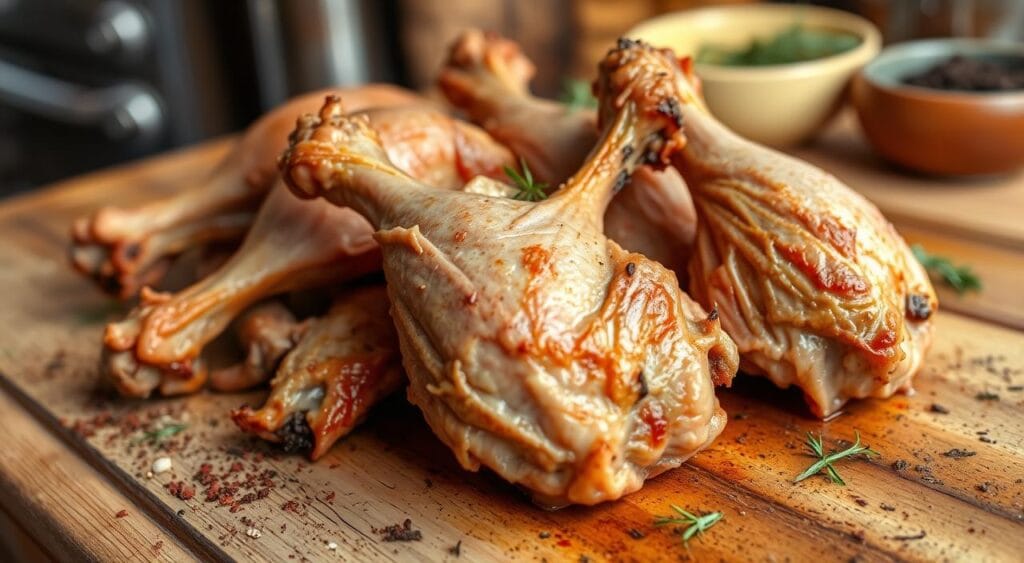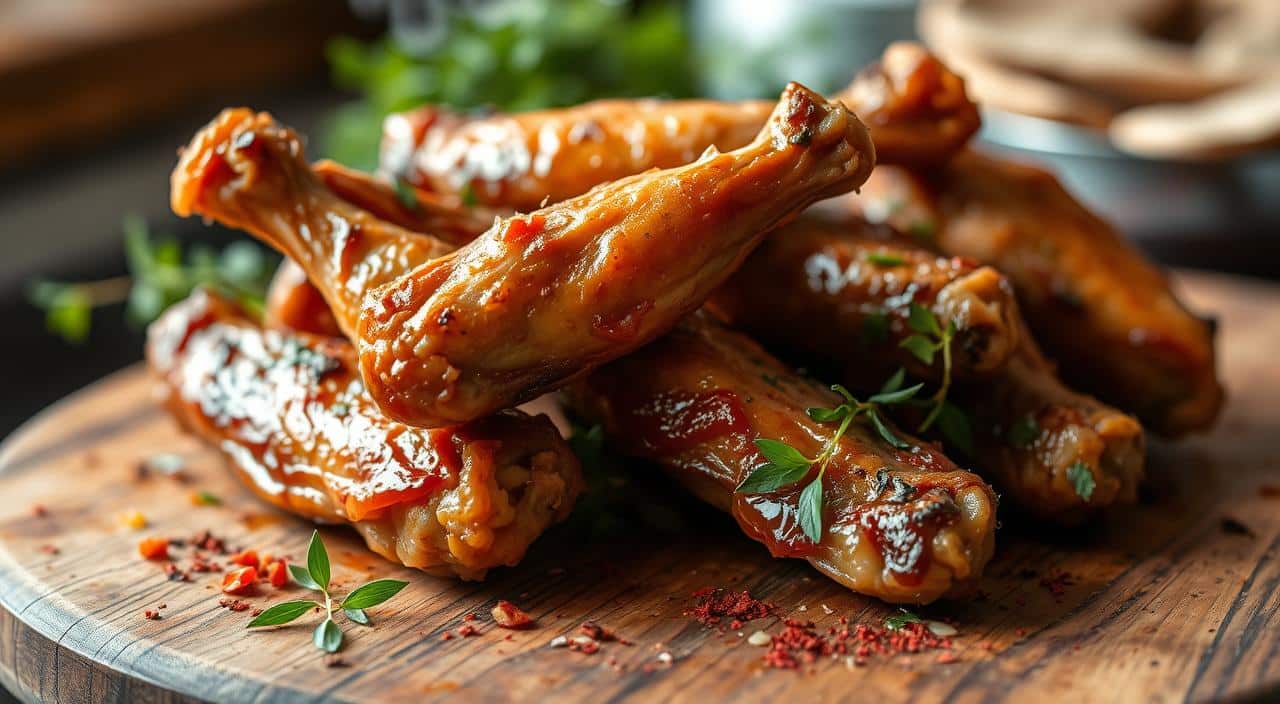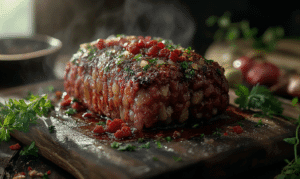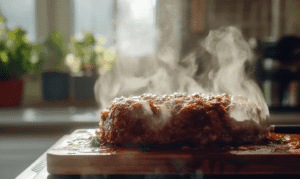Jump to:
Estimated reading time: 9 minutes
Table of contents
Perfectly cooked turkey wings should be tender, juicy, and full of flavor. But many home cooks face the problem of tough, dry turkey wings. Whether it’s for a holiday feast or a casual meal, nobody wants tough wings.
In this guide, we’ll look at why turkey wings can be tough. We’ll also share tips to make sure your wings are always tender. You’ll learn how to avoid this problem and serve delicious turkey wings every time.
Why are my turkey wings tough? Key Takeaways
- Overcooking or cooking at too high a temperature can lead to tough, dry turkey wings
- Improper marinating, brining, or thawing can also contribute to toughness
- Choosing the right cooking method and monitoring internal temperature are crucial for tender wings
- Quick fixes like reheating in a moist environment or shredding can rescue tough wings
- Consistent low and slow cooking is the key to achieving juicy, tender turkey wings
Why are my turkey wings tough? Introduction
When it comes to baked turkey wings, oven-roasted turkey wings, and delicious turkey wing recipes, getting them just right can be tough. The secret is knowing why they might turn out tough and using the best ways to cook them. This way, your wings will always be tender and juicy.
In this article, we’ll explore why turkey wings can be tough and dry. We’ll share tips and solutions to make your wings tender and full of flavor. We’ll talk about marinating, brining, and the best cooking methods to make your turkey wings a hit at your next meal.
“The secret to delicious turkey wings is all in the preparation. By understanding the common pitfalls and using the right techniques, you can elevate this humble cut into a truly mouthwatering masterpiece.”
So, whether you’re an experienced cook or just starting out, you’re in for a treat. Get ready to learn how to make your turkey wings tender and juicy every time.

Common Reasons Why Turkey Wings Become Tough
Turkey wings are tasty and versatile, but they can get tough if not cooked right. Overcooking and not enough moisture are main reasons. Knowing these issues helps make your turkey wings juicy and tender.
Overcooking the Turkey Wings
Overcooking is a big reason for tough turkey wings. Cooking them too long makes the meat dry and stringy. Turkey wings should be cooked to 165°F for safety, but overdoing it makes them tough.
Cooking at Too High a Temperature
Cooking wings too hot also makes them tough. High heat, like grilling or frying, can make the skin hard while the inside stays raw. Slow cooking is better for tender wings.
Not Enough Moisture During Cooking
Moisture is key for tender wings. Without enough liquid, they dry out. Braising, simmering, or wrapping in foil helps keep them moist.
Knowing why turkey wings get tough helps cooks improve their methods. This way, your turkey wings will always be tender and tasty.

How Preparation Methods Affect Turkey Wing Tenderness
Getting tender, juicy turkey wings begins with the right prep. How you handle and season your wings before cooking greatly affects their texture and taste.
Improper Marinating or Seasoning
Marinating wings in a mix of herbs, spices, and acids tenderizes them. But, if the marinade is uneven or stays too long, it can make the wings salty or tough. It’s important to coat the wings well and marinate them for the right amount of time.
Skipping the Brining Process
Brining, or soaking wings in saltwater, is key for better texture. It breaks down proteins, making the wings tender and juicy. Without brining, wings can end up dry and tough, no matter the cooking method.
Using Frozen Turkey Wings Without Proper Thawing
When using frozen wings, thawing them completely before cooking is crucial. Cooking frozen wings can cause some parts to dry out while others stay raw. Thawing in the fridge or using the defrost setting on your microwave is necessary for the best results.
By focusing on these important prep steps, you can make sure your turkey wings are tender and delicious every time.
Cooking Techniques That Lead to Tough Turkey Wings
The way you cook your turkey wings can make a big difference. Using methods like grilling or frying at high heat can dry out the outside. At the same time, the inside might not cook fully.
Baking without covering the wings can also make them tough and leathery. This is because the wings lose moisture, making the meat tight and chewy.
Grilling or Frying at High Heat
Cooking turkey wings at high heat can sear the outside too quickly. This leaves the inside raw and uneven. The result is a dry, tough exterior and a bad texture.
Baking Without Covering
Baking wings without covering them can dry out the outside. The oven’s dry environment takes away the wings’ natural juices. This makes the wings less juicy and less tasty.
Slow Cooking Without Enough Liquid
Slow cooking turkey wings needs enough liquid, like broth or sauce. Without it, the wings can become tough and stringy. They won’t be as tender as slow cooking should make them.
“The key to tender, juicy turkey wings is finding the right balance of cooking method, temperature, and moisture.”
Tips for Making Turkey Wings Tender and Juicy
To make turkey wings tender and juicy, focus on preparation and cooking techniques. Here are some expert tips to ensure your turkey wings are moist and flavorful every time:
Proper Marinating and Brining Techniques
Marinating the turkey wings in a flavorful liquid, like a marinade with lemon juice, garlic, breaks down tough fibers. Brining them in saltwater solution makes them juicier and more seasoned.
Choosing the Right Cooking Method
Slow cooking the turkey wings, whether baking them covered or braising them in sauce, keeps them moist. This method tenderizes the meat and keeps the juices in.
Resting the Turkey Wings Before Serving
After cooking, let the turkey wings rest for a few minutes before serving. This lets the juices spread evenly, making each bite tender and juicy.
By following these tips, you can make tender, flavorful turkey wings. They will impress your family and friends. Enjoy their rich taste and versatility.
How to Rescue Tough Turkey Wings: Quick Fixes
If your turkey wings are tough and dry, don’t worry. There are easy ways to make them tender and juicy again.
Reheating in a Moisture-Rich Environment
One good trick is to reheat them in a moist place. You can simmer them in a tasty broth or sauce. Or wrap them in foil with some liquid and bake them in the oven. This adds moisture and makes the meat tender.
Shredding and Using in Soups or Stews
If the shredded turkey wings are still tough, use them in soups or stews. The long cooking time and liquid will soften the meat. This makes it tender and easy to eat.
Braising with Broth or Sauce
For a hands-on fix, braise the tough turkey wings in a flavorful liquid. Use chicken or turkey broth until they’re very tender. This method breaks down the tough fibers, making the wings deliciously braised.
With a bit of creativity and the right cooking methods, you can make tough turkey wings into a tasty meal. Don’t hesitate to try different approaches to find what works best for you.
Preventing Tough Turkey Wings in the Future
To avoid tough turkey wings, take a few steps. Make sure to check the internal temperature of the wings. Remove them from heat when they hit 165°F. This stops them from getting overcooked.
Cooking the wings low and slow is also key. You can do this in the oven, slow cooker, or braiser. This method keeps them tender and juicy. Always use a meat thermometer to check the temperature accurately.
Monitoring Internal Temperature
The perfect internal temperature for turkey wings is 165°F (74°C). Use a meat thermometer to check this. It makes sure the wings are cooked right without drying out.
Cooking Low and Slow
Start by preheating your oven to 325°F (163°C). This helps the wings cook evenly. Marinating the wings overnight can also add flavor and make them tender.
Using a Meat Thermometer for Precision
A meat thermometer is essential for cooking turkey wings right. It lets you know when to take the wings out. This way, you avoid overcooking and keep them juicy.
“Closely monitoring the internal temperature of the wings and removing them from heat once they reach 165°F is crucial to preventing overcooking.”
Frequently Asked Questions
Why do turkey wings sometimes turn out tough?
Turkey wings can turn out tough if they are not cooked for long enough or at a low enough temperature. Turkey wings have more connective tissue than other cuts, so they benefit from slow, low-heat cooking methods to achieve tenderness.
How can I make my turkey wings more tender?
To make turkey wings more tender, try cooking them in a slow cooker or braising them in the oven with liquid, such as broth or sauce. This breaks down connective tissues, resulting in juicier, softer meat.
At what temperature should I cook turkey wings to avoid toughness?
Cooking turkey wings at a lower temperature, around 300°F to 325°F, for an extended time helps ensure they come out tender. This allows the meat to cook thoroughly without drying out.
Can marinating help make turkey wings less tough?
Yes, marinating turkey wings in acidic ingredients like lemon juice or vinegar for a few hours can help break down muscle fibers, making them more tender after cooking.
Conclusion
Understanding why turkey wings can be tough helps you make them tender and juicy. By following the right steps, you can make perfectly tender, juicy turkey wings every time. This guide covers brining, marinating, and choosing the best cooking method.
It also talks about checking the internal temperature. These tips will help you avoid tough turkey wings. They’re great for any meal, whether as a main dish or an appetizer.
With the right techniques, your turkey wings can be tender, flavorful, and juicy. This will impress your guests. You’ll improve your cooking skills and bring soul food flavors to your table.
So, when you want perfect turkey wings, use what you’ve learned. A bit of care and the right methods will make your turkey wings delicious. Your family and friends will love them.






